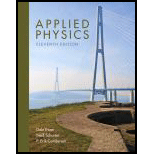
Concept explainers
Aaron a bicycle mechanic, is studying the mechanical advantage of the rear wheel The rear wheel’s radius is 14.0 in and the chain is currently on a gear with radius 1.65 in. (Fig. 10.3  ). (a) If the chain applies a force of 54.5 lb on the wheel, what is the mechanical advantage of the wheel? (b) What is the resistance force? (c) Haw many inches of chain must be used to turn the wheel one complete rotation? (d) Finally, under what circumstances is it beneficial for a bicycle to have a mechanical advantage less than 1.0?
). (a) If the chain applies a force of 54.5 lb on the wheel, what is the mechanical advantage of the wheel? (b) What is the resistance force? (c) Haw many inches of chain must be used to turn the wheel one complete rotation? (d) Finally, under what circumstances is it beneficial for a bicycle to have a mechanical advantage less than 1.0?
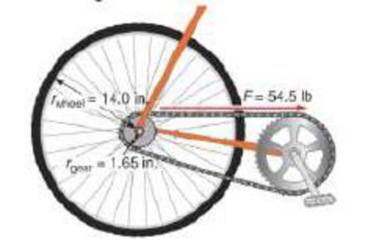
Figure 10.31
Want to see the full answer?
Check out a sample textbook solution
Chapter 10 Solutions
Applied Physics (11th Edition)
Additional Science Textbook Solutions
Physics for Scientists and Engineers with Modern Physics
College Physics
Conceptual Physical Science (6th Edition)
Lecture- Tutorials for Introductory Astronomy
University Physics (14th Edition)
Life in the Universe (4th Edition)
- Show compete solution The diameter of a bicycle is 26 inches. If you are travelling at a speed of 35miles per hour on the bicycle, through how many revolutions per minute arethe wheel turning?arrow_forwardA typical car has an axle with 1.10 cm radius driving a tire with a radius of 27.5 cm . What is its mechanical advantage assuming the very simplified model in Figure 9.25(b)?arrow_forwardWhen a motor is set on a pivoted mount seen below, its weight can be used to maintain tension in the drive belt. When the motor is not running the tensions T1 and T2 are equal. The total mass of the platform and the motor is 100.0 kg, and the diameter of the drive belt pulley is 16.0 cm. When the motor is off, find: (a) the tension in the belt, and (b) the force at trhe hinged platform support at point C. Assume that the center of mass of the motor plus platform is at the center of the motor.arrow_forward
- Weights are gradually added to a pan until a wheel of mass M and radius R is pulled over an obstacle of height d, as shown below. What is the minimum mass of the weights plus the pan needed to accomplish this?arrow_forwardA solid cylindrical wheel of mass M and radius R is pulled by a force applied to the center of the wheel at 37 to the horizontal (see the following figure). If the wheel is to roll without slipping, what is the maximum value of ? The coefficients of static and kinetic friction are s=0.40 and k=0.30 .arrow_forwardPulleys introduce a possible source of error because of their possible friction. Given that they are a source of error, why are the pulleys used at all? What is the function of the pulleys?arrow_forward
- A ball is turned by a force of 52 N which is applied perpendicularly at the end of the handle of a wrench. The wrench is 0.30 m long. What is the torque applied by the wrench?arrow_forwardConsider the nail puller shown (image attached) What is the mechanical advantage of a nail puller where you exert a force 43.5 cm from the pivot and the nail is 2.3 cm on the other side? What minimum force must you exert to apply a force of 1500 N to the nail?arrow_forwardWhat is the mechanical advantage of a wheel with a radius of 68 cm mounted on an axle with a radius of 2.0 cm when the input force is applied to the wheel? Needs Complete typed solution with 100 % accuracy.arrow_forward
- The wheel and axle of a wheel -and -axle have radii 50cm and 10cm respectively. if one -fifth of the work done by the effort is used in overcoming friction, an effort of 500N applied to the wheel will raise what amount of load ? Please don't answer in hand written.. please avoid hand writtenarrow_forwardA force is applied on a pulley as shown above. What is the torque (in unit of N.m) delivered by the force?arrow_forwardDescribe the Statics and Torque:arrow_forward
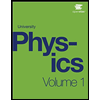 University Physics Volume 1PhysicsISBN:9781938168277Author:William Moebs, Samuel J. Ling, Jeff SannyPublisher:OpenStax - Rice University
University Physics Volume 1PhysicsISBN:9781938168277Author:William Moebs, Samuel J. Ling, Jeff SannyPublisher:OpenStax - Rice University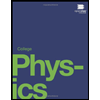 College PhysicsPhysicsISBN:9781938168000Author:Paul Peter Urone, Roger HinrichsPublisher:OpenStax College
College PhysicsPhysicsISBN:9781938168000Author:Paul Peter Urone, Roger HinrichsPublisher:OpenStax College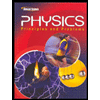 Glencoe Physics: Principles and Problems, Student...PhysicsISBN:9780078807213Author:Paul W. ZitzewitzPublisher:Glencoe/McGraw-Hill
Glencoe Physics: Principles and Problems, Student...PhysicsISBN:9780078807213Author:Paul W. ZitzewitzPublisher:Glencoe/McGraw-Hill


